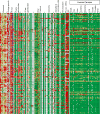Open Source Drug Discovery with the Malaria Box Compound Collection for Neglected Diseases and Beyond
- PMID: 27467575
- PMCID: PMC4965013
- DOI: 10.1371/journal.ppat.1005763
Open Source Drug Discovery with the Malaria Box Compound Collection for Neglected Diseases and Beyond
Abstract
A major cause of the paucity of new starting points for drug discovery is the lack of interaction between academia and industry. Much of the global resource in biology is present in universities, whereas the focus of medicinal chemistry is still largely within industry. Open source drug discovery, with sharing of information, is clearly a first step towards overcoming this gap. But the interface could especially be bridged through a scale-up of open sharing of physical compounds, which would accelerate the finding of new starting points for drug discovery. The Medicines for Malaria Venture Malaria Box is a collection of over 400 compounds representing families of structures identified in phenotypic screens of pharmaceutical and academic libraries against the Plasmodium falciparum malaria parasite. The set has now been distributed to almost 200 research groups globally in the last two years, with the only stipulation that information from the screens is deposited in the public domain. This paper reports for the first time on 236 screens that have been carried out against the Malaria Box and compares these results with 55 assays that were previously published, in a format that allows a meta-analysis of the combined dataset. The combined biochemical and cellular assays presented here suggest mechanisms of action for 135 (34%) of the compounds active in killing multiple life-cycle stages of the malaria parasite, including asexual blood, liver, gametocyte, gametes and insect ookinete stages. In addition, many compounds demonstrated activity against other pathogens, showing hits in assays with 16 protozoa, 7 helminths, 9 bacterial and mycobacterial species, the dengue fever mosquito vector, and the NCI60 human cancer cell line panel of 60 human tumor cell lines. Toxicological, pharmacokinetic and metabolic properties were collected on all the compounds, assisting in the selection of the most promising candidates for murine proof-of-concept experiments and medicinal chemistry programs. The data for all of these assays are presented and analyzed to show how outstanding leads for many indications can be selected. These results reveal the immense potential for translating the dispersed expertise in biological assays involving human pathogens into drug discovery starting points, by providing open access to new families of molecules, and emphasize how a small additional investment made to help acquire and distribute compounds, and sharing the data, can catalyze drug discovery for dozens of different indications. Another lesson is that when multiple screens from different groups are run on the same library, results can be integrated quickly to select the most valuable starting points for subsequent medicinal chemistry efforts.
Conflict of interest statement
The following commercial organizations employ or employed some of the authors, which might be considered a conflict of interest by some readers: BBD BioPhenix SL—BIOBIDE: Aintzane Alday PhD, Ainhoa Alzualde PhD, and, Arantza Muriana; Celia Quevedo PhD; SCYNEXIS, Inc.: Tana Bowling, Audrey Burton, Luke Mercer, and, Bakela Nare PhD; GlaxoSmithKline: Francisco Javier Gamo, PhD, Maria Jose Lafuente, PhD, and Sarah Prats; Eisai Co., Ltd.: Takaaki Horii Ph.D. and Nao-aki Watanabe Ph.D.; Novartis Inc.: Mark Baker PhD MSc (med), and David M. Plouffe; Definiens AG: Andreas Spitzmüller PhD; and, Merck Serono Inc: Thomas Spangenberg PhD.
Figures


References
Publication types
MeSH terms
Substances
Grants and funding
- R21 AI103664/AI/NIAID NIH HHS/United States
- U19 AI111143/AI/NIAID NIH HHS/United States
- R01 GM097350/GM/NIGMS NIH HHS/United States
- T32 GM080189/GM/NIGMS NIH HHS/United States
- HHMI/Howard Hughes Medical Institute/United States
- R01 AI116665/AI/NIAID NIH HHS/United States
- R01 AI079092/AI/NIAID NIH HHS/United States
- U19 AI089681/AI/NIAID NIH HHS/United States
- R01 AI097218/AI/NIAID NIH HHS/United States
- R01 LM012222/LM/NLM NIH HHS/United States
- R01 AI117017/AI/NIAID NIH HHS/United States
- R21 AI105657/AI/NIAID NIH HHS/United States
- R21 AI101381/AI/NIAID NIH HHS/United States
- R01 GM104486/GM/NIGMS NIH HHS/United States
- R01 AI094973/AI/NIAID NIH HHS/United States
- T32 GM007198/GM/NIGMS NIH HHS/United States
LinkOut - more resources
Full Text Sources
Other Literature Sources
Medical
Molecular Biology Databases
Miscellaneous

